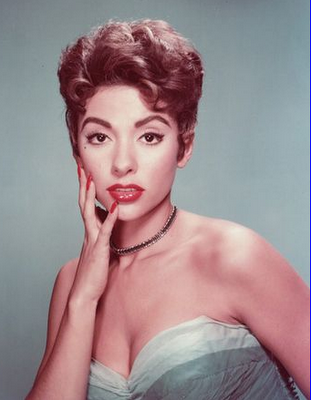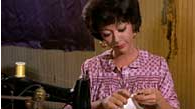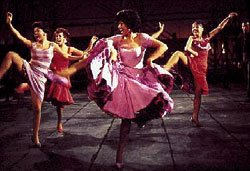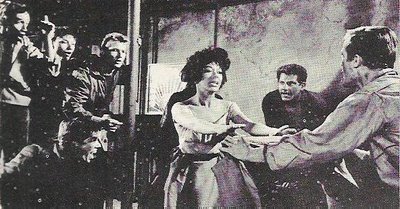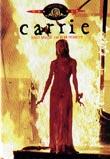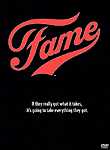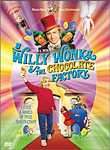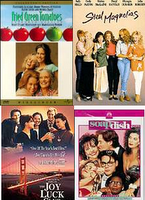 post is the second in my multi-part mini-treatise regarding the current Broadway production of West Side Story at The Palace Theatre in New York City. What I had hoped would be a quick overview of my reactions to the production soon morphed into something more substantial -- or, if not substantial, then too BIG for a single post. So, I've elected to spread my "5 Stinky Thoughts on West Side Story (2009)" across this week...
post is the second in my multi-part mini-treatise regarding the current Broadway production of West Side Story at The Palace Theatre in New York City. What I had hoped would be a quick overview of my reactions to the production soon morphed into something more substantial -- or, if not substantial, then too BIG for a single post. So, I've elected to spread my "5 Stinky Thoughts on West Side Story (2009)" across this week...Thought #3: It's All about Sex?
One of the more striking features of the 2009 West Side Story is its relative sexual frankness. Indeed, librettist (and director of the current production) Arthur Laurents has been telling pretty much anyone who'll listen that West Side Story is "all about sex." (Exhibit A, B.) Not gangs, not racism, not love -- SEX. Now, I don't know that I disagree. It's always been a thrill to see The Jets and The Sharks be so athletic and so balletic and the fun of Anita derives in no small part from her sexual confidence ("You forget I'm in Ameríca!"). The original 1957 production was, by some accounts, something of a cult hit among gay men of the era, not because of the proto-pride anthem "Somewhere," but because of all the young (mostly gay) dancers wearing tight jeans. But in this production, the sexually exuberant Laurents amplifies the sexual currents within the show into something like an overall concept. In the 2009 version, there's little doubt that Tony and Maria are horny for each other. As Laurents himself notes, they can barely get through their balcony duet because they can't keep their hands off each other. Comparably, it's clear that Tony and Maria are having sex "during" the "Somewhere Ballet" and that their sexual connection is the foundation for their belief in a better world. Indeed, it seems to me that Laurents's frank and celebratory interest in sex marks this production's most notable departures from more conventional productions (even, I daresay, more than the addition of Spanish lyrics and incidental dialogue).
 While I get it that the sexuality is absolutely essential in West Side Story, and while I get it that Laurents and Robbins landed at nearly opposite ends of the sexual liberation spectrum, I wonder if Laurents's exuberant amplification in this production is entirely effective. Please don't misunderstand: I agree that -- especially with regard to Tony/Maria -- the sexual frankness proves productive in clarifying the characters's motives. However, in this production, it's the other sex stuff that I found odd, discordant, even distracting. My biggest beef came in one of the production's most substantial dialogue changes: GladHand's speech introducing the "Get Together Dance," in which he endeavors -- with ostensibly comic incompetence -- to speak bilingually about the importance of abstinence to the assembled teens. The addition of this material seems to me to be part of Laurents's general intervention in this production, his oddly quaint insistence that teenagers have sex and its a bad idea to pretend that they don't. However, in the particular case of Glad Hand's "abstinence" speech, the changes feel like ahistorical editorializations. (Historically, the discourse of abstinence was not popularly applied to sex education efforts until well after such programs were introduced in the 1970s; the kind of "settlement house" extension work done by GladHand in the 1950s operated from a premise of "sexual hygiene" in which things like chaperoned dances encouraged "appropriate" social interaction. The idea was that, left to their own devices, kids would "get busy" so better to keep them busy with more appropriate activities.) As such, GladHand's abstinencia scene just felt off-kilter, both historically and conceptually. Comparably, I found it startling that the incidental dialogue added for this production included The Sharks's shouting of "maricón" -- as well as a handful of other obscenities en español -- without comparable trashtalk from The Jets. Where the 2009 Jets DID get their filth on was in the realm of wordless gestures -- crotch-grabbing mostly, though also including one especially strange wiener wagging moment and an incongruously trashy costume for Graziella. All of which felt tacky, like high schoolers pretending to be sexually "dangerous." Finally, I found it fascinating that what has long felt to me to be the queerest moment in the piece (the brief scene between A-rab and BabyJohn after the Rumble, in which the two young men find comfort with one another) is played with a near absence of genuine feeling (perhaps due to Kyle Coffman's twitchy performance as A-rab).
While I get it that the sexuality is absolutely essential in West Side Story, and while I get it that Laurents and Robbins landed at nearly opposite ends of the sexual liberation spectrum, I wonder if Laurents's exuberant amplification in this production is entirely effective. Please don't misunderstand: I agree that -- especially with regard to Tony/Maria -- the sexual frankness proves productive in clarifying the characters's motives. However, in this production, it's the other sex stuff that I found odd, discordant, even distracting. My biggest beef came in one of the production's most substantial dialogue changes: GladHand's speech introducing the "Get Together Dance," in which he endeavors -- with ostensibly comic incompetence -- to speak bilingually about the importance of abstinence to the assembled teens. The addition of this material seems to me to be part of Laurents's general intervention in this production, his oddly quaint insistence that teenagers have sex and its a bad idea to pretend that they don't. However, in the particular case of Glad Hand's "abstinence" speech, the changes feel like ahistorical editorializations. (Historically, the discourse of abstinence was not popularly applied to sex education efforts until well after such programs were introduced in the 1970s; the kind of "settlement house" extension work done by GladHand in the 1950s operated from a premise of "sexual hygiene" in which things like chaperoned dances encouraged "appropriate" social interaction. The idea was that, left to their own devices, kids would "get busy" so better to keep them busy with more appropriate activities.) As such, GladHand's abstinencia scene just felt off-kilter, both historically and conceptually. Comparably, I found it startling that the incidental dialogue added for this production included The Sharks's shouting of "maricón" -- as well as a handful of other obscenities en español -- without comparable trashtalk from The Jets. Where the 2009 Jets DID get their filth on was in the realm of wordless gestures -- crotch-grabbing mostly, though also including one especially strange wiener wagging moment and an incongruously trashy costume for Graziella. All of which felt tacky, like high schoolers pretending to be sexually "dangerous." Finally, I found it fascinating that what has long felt to me to be the queerest moment in the piece (the brief scene between A-rab and BabyJohn after the Rumble, in which the two young men find comfort with one another) is played with a near absence of genuine feeling (perhaps due to Kyle Coffman's twitchy performance as A-rab). I could go on, and I might, especially about Laurents's reinterpretation of the "Somewhere" ballet as an earthtone idyll (I kept waiting for someone to start singing "I Believe That Children Are Our Future") and how Laurents's emphasis on sexuality mark the most substantial shifts in the production, not the addition of the bits of Spanish here and there. And, admittedly, I find it strange that I'm levying this charge ("Laurents put too much sex in West Side Story!"). But when I track the actual ways that this production is a "revisal" of the original, it seems to me that the sex changes are fundamental while the Spanish stuff is almost incidental and, quite possibly, the sex changes might choreograph the most significant of the production's accumulation of missteps.
I could go on, and I might, especially about Laurents's reinterpretation of the "Somewhere" ballet as an earthtone idyll (I kept waiting for someone to start singing "I Believe That Children Are Our Future") and how Laurents's emphasis on sexuality mark the most substantial shifts in the production, not the addition of the bits of Spanish here and there. And, admittedly, I find it strange that I'm levying this charge ("Laurents put too much sex in West Side Story!"). But when I track the actual ways that this production is a "revisal" of the original, it seems to me that the sex changes are fundamental while the Spanish stuff is almost incidental and, quite possibly, the sex changes might choreograph the most significant of the production's accumulation of missteps.









